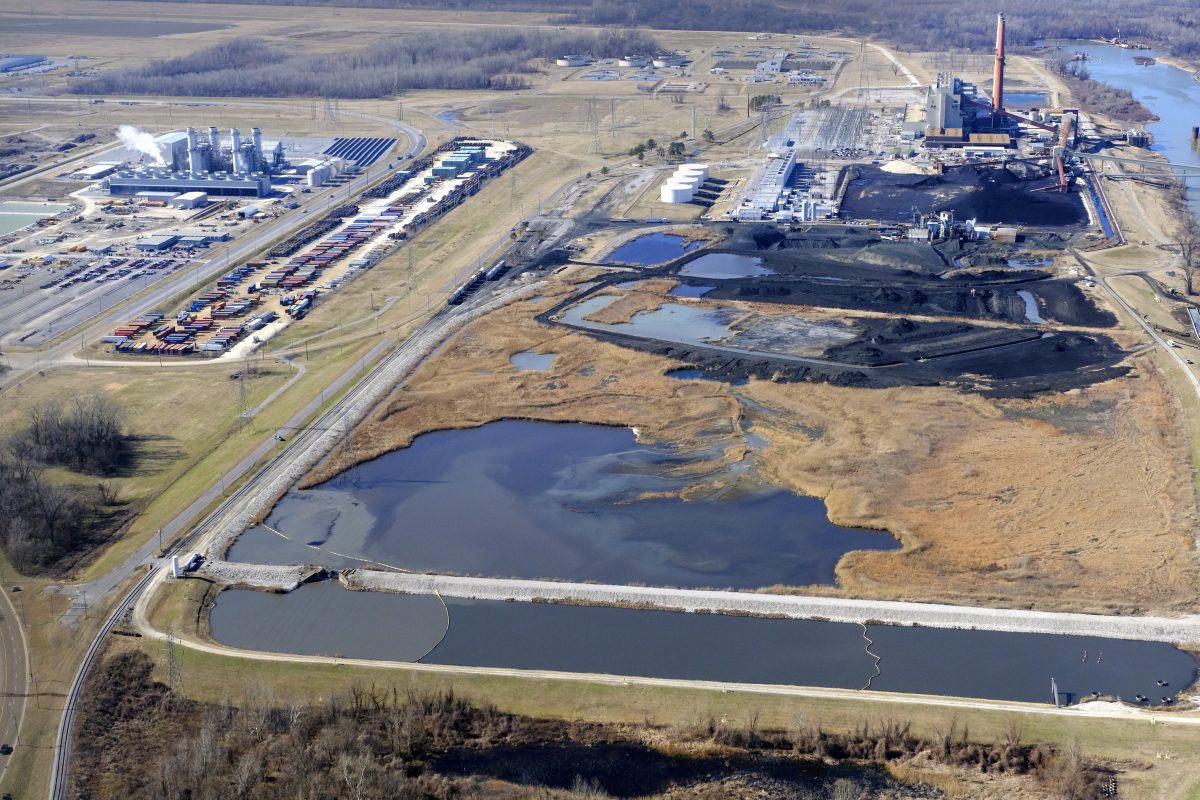Blue Oval City, the planned automotive assembly plant operated by Ford Motor Company and SK Innovation, supercharged local imaginations. Jobs, business, and money — sure — but this project could allow West Tennessee to be a rugged, “built-Ford-tough” cowboy from the past and Captain Planet for the future at the same time.
The project proves Ford Motor Co. is dead serious about that marriage of ideas. The 1,500-acre campus will cost $5.6 billion to build, the biggest manufacturing investment in the company’s history. The planned megacampus in Haywood County is the first Ford will build “in more than a generation.”
This bold pivot to electric vehicles was a hard-to-miss shift in the wind. It’s a massive bet that customers still want the mythical, American self-reliance projected by its iconic F-150 truck — but they also want it without the gas-guzzling, planet-choking, tailpipe fog of most cars made in the last 100 years.
The moment was bold enough that Ford CEO Bill Ford told reporters, “We’re on the cusp of a revolution,” one that would help “build a better future for America.” It doesn’t stop at trucks.
“The all-new megacampus just outside of Memphis, called Blue Oval City, aspires to have 100 percent renewable energy, zero waste to landfill, and reusing every drop of water, to ensure our planet is in it for the long haul,” Ford Motor Co. tweeted at the time.
But if nothing changes, and without help from other programs, the all-electric F-150 Lightnings that roll off the line here first will be ready for antique Tennessee license plates by the time that plant is powered entirely by renewable energy. Blue Oval City sits squarely in the Tennessee Valley Authority (TVA) service area, and that power provider says it won’t be carbon-neutral until 2050, about 25 years after the Ford plant is expected to open.
If TVA’s power mix remains the same, that cutting-edge factory — and those Earth-saving trucks — will be charged with a mix heavy with nuclear power, coal, and natural gas. Only 14 percent of TVA’s power-generation portfolio is renewable, including hydroelectric (11 percent), wind and solar (3 percent), and some energy-efficiency programs (1 percent). But TVA says their Green Invest turnkey solar program “can help businesses like Ford achieve their sustainability goals using 100 percent renewable energy.” TVA says it leads its Southeastern peers with a generation portfolio that is already 63 percent carbon-free.
Throughout the Tennessee River Valley, major corporations, big Tennessee companies, cities, counties, and more have publicly stated environmental goals. They all want to reduce waste and reduce their carbon footprints, meaning they want less reliance on fossil fuels and more on renewables, like wind and solar.
TVA knows this, according to internal documents, and considers it a threat to its bottom line, one it means to fix. If this sounds off, U.S. House members thought so, too, enough to launch an investigation into TVA’s business practices on renewables.
Joined at the Hip on Climate Change
Memphis and Shelby County’s climate goals around renewable energy will depend much on TVA, and some say that could be problematic.
Greenhouse gas emissions from energy accounted for nearly half (46 percent) of all of the Memphis area’s total emissions, according to the latest environmental inventory taken back in 2016 for the Memphis Area Climate Action Plan adopted in 2019. Energy emissions include those in buildings: houses, apartments, stores, salons, banks, museums, restaurants, warehouses, factories, and more. The rest were emissions from two other major categories: transportation (52 percent) and waste (like landfills and wastewater treatment) at 12 percent.
The climate plan — approved by the Memphis City Council, the Shelby County Commission, Memphis Mayor Jim Strickland, and Shelby County Mayor Lee Harris — commits these governments to developing renewable energy generation at key facilities (like solar panels on government buildings) and/or buying renewables through energy certificates, green tariff products, and participating in community shared solar projects.
But those are details. The plan and, therefore, everyone who approved it, agreed on one thing: “grid decarbonization — or increasing the carbon-free energy sources in our electric supply — has the greatest impact on reducing greenhouse-gas emissions in our community.” They all agreed, too, that there was little they could do about it.
“As noted in the discussion of community-wide education targets, a large portion of these 2020 reductions are expected as a result of actions outside local control,” reads the plan, “for example, TVA’s planned increase in carbon-free energy sources in their energy portfolio.”
To see just how closely the city’s goals are dependent on TVA, consider their timelines to carbon-free energy. The Memphis Area Climate Action Plan calls for the electric grid to be 80 percent carbon-free by 2035. So do TVA’s plans. (Even though President Joe Biden’s climate goals want totally carbon-free energy by 2035.) Memphis-area leaders want a completely carbon-free electric grid by 2050. So does TVA.
A mix of solar and wind projects helped the TVA to reduce carbon emissions by 63 percent from 2005 to 2020. But solar leads the way in the Southeast, and TVA says it’ll be mainly solar projects that will aid it in its future reductions.
But environmental watchdog groups claim TVA has thrown up roadblocks to solar projects, especially for homeowners and business owners, to protect its finances. The reasons are complicated, but one thing is clear to Maggie Shober, research director with the Southern Alliance for Clean Energy (SACE).
“TVA is behind,” Shober said on solar energy. “TVA is behind the Southeast, and the Southeast is behind the rest of the country.”
However, TVA says it is now building the “energy system of the future,” which aspires to net-zero emissions by 2050 and to add 10,000 megawatts of solar.
Where Do We Stand?
When it comes to solar, Tennessee (with about 390 megawatts of solar capacity) ranks third to last in the Southeast, ahead of only Mississippi (362 megawatts) and Alabama (319 megawatts). Florida leads the region with 7,765 megawatts of solar capacity, followed by North Carolina (7,460 megawatts) and Georgia (3,444 megawatts). All of this is according to late-2021 figures from the Solar Energy Industries Association.
Among power providers in the Southeast with more than 500,000 customers, TVA ranks 10th of 13 on solar watts per customer, according to SACE’s annual “Solar in the Southeast” report. The Southeast average of watts per customer is 423 watts. TVA provides 105 solar watts per customer, according to the report. The highest is North Carolina’s Duke Energy with 1,952 solar watts per customer. The lowest is Tampa, Florida’s Seminole Electric Co-Op, providing only 45 solar watts per customer.
Among TVA’s biggest Tennessee customers, Memphis Light, Gas and Water (MLGW) ranks second for solar watts per customer. MLGW offers 66 solar watts per customer, only slightly behind Nashville Electric Service, offering 67 solar watts per customer. These figures fall below the Southeast average of 423 solar watts per customer and the TVA average of 90 watts per customer hour.
So, Tennessee ranks near the bottom on solar. TVA ranks near the bottom on solar. And MLGW ranks below TVA’s average for access to solar power.
“TVA will be quadrupling solar capacity by 2024, yet continues to trail the other large utility systems in the Southeast,” reads the SACE report. “By 2024, SACE projects TVA to reach the 2020 region average.”
Winds Don’t Blow
In 2010, Houston-based Clean Line Energy Partners answered a call from the U.S. Department of Energy for a new project to modernize the country’s electric transmission structure, increase domestic energy sources, support new jobs, and do it all without taxpayer money. Clean Line proposed a $2.5 billion, 700-mile-long transmission line from Oklahoma to end at a connector near Millington.
If the deal was done, 3,500 megawatts of clean wind power from Oklahoma and Texas would have pumped through Memphis and into the TVA service area and beyond starting in 2020. But it wasn’t. So, it’s not. And TVA was the deal-breaker.
The connector project alone was valued at $259 million. It had broad support here from government, civic, and business groups. It was even supported by the Memphis and Shelby County Economic Development Growth Engine (EDGE) with $23.3 million in tax breaks, which the group said would yield $37.1 million in benefits back to the community.
Then-Senator Lamar Alexander (R-Maryville) opposed the project, claiming the power was unreliable and that, over decades, it would increase TVA rates. Then-Shelby County Commissioner Terry Roland (R-Millington) fired back at Alexander, a fellow Republican, claiming the project would be a financial boon for the area and that Alexander “put his own agenda ahead of what’s best for West Tennessee.”
For TVA, though, the clean-energy deal got down to economics. After nearly seven years of study — with the company spending money to move the project forward — TVA said it didn’t really need any extra power, no matter the source.
Bill Johnson, TVA president at the time, told the Chattanooga Times Free Press in 2017, “We’re looking at a power demand in the future that is flat, or declining slightly, so we don’t anticipate needing major additions to power generation for a decade or more.”
While TVA said the move did not make financial sense at the time, it welcomed Clean Line to come back with a new proposal. They did not. The company withdrew its proposal at the end of 2017 and sold the land for the project to NextEra Energy, the world’s largest utility company, to divert more wind power to the Southwest.
Environmentalists blasted TVA’s “thanks, but no thanks” on the wind-energy project. Others, like Alexander, celebrated it as a solid example of financial stewardship. Either way, it remains TVA’s highest-profile example of saying “thanks, but no thanks” to renewables, especially ones it does not own.
A Rate-Making Rubik’s Cube
While the Clean Line dismissal was a high-dollar, high-profile deal conducted largely in public, some say TVA is still blocking renewables, especially solar, in a smaller, more complicated way. But it’s a way that directly affects and involves its customers.
In 2018, TVA approved a “grid access fee.” With it, TVA charges MLGW the fee to use its electricity grid and 7,000 miles of transmission lines. If demand for TVA’s power will stay the same or go down in the future, as former TVA CEO Johnson said in 2017, then that means fewer dollars for TVA as expenses rise. Fixed fees, like the grid access charge, ensure a steadier stream of dollars, instead of the up-and-down whims of market demand.
The Sierra Club explained grid access fees this way: “TVA’s board of directors today approved a mandatory fixed fee that will force customers to pay more on their electric bill before they even flip a switch.”
MLGW spokeswoman Stacey Greenberg said the utility, TVA’s largest customer, paid $59.1 million in grid access fees in the 2021 fiscal year. When asked if those fees were passed on to MLGW customers, Greenberg said, “As stated in the response to the first question, the change was a revenue neutral change at the system level and MLGW did not change the fixed or variable portions of any retail rates.” After press time, Greenberg clarified that the fees are passed on to MLGW customers. She said the average residential customer pays about $6.24 each year for the grid access fee.
So, what does this have to do with solar? These fees will remain the same no matter how much solar you sell back to the grid. Solar advocates say these fees undercut savings on electric bills and, therefore, cut the amount of clean, renewable solar power that businesses and homeowners will install on their buildings.
But in 2018, TVA said solar projects for specific sites were not fair and that its current energy prices “over-incentivize consumer installation of [distributed energy sources like solar] leading to uneconomic results for the people of the Valley as a whole.”
“Over the next decade, forecasted load is expected to be flat or declining, resulting in little need for new energy sources,” according to a 2018 TVA report. “At the same time, consumer interest in renewable energy continues to rise. The imbalance created by uneconomic [on-site solar projects] investment means that costs are shifted to consumers throughout the Valley who cannot afford [on-site solar projects] or otherwise choose not to invest in [on-site solar projects].”
But it came to light that dissing these solar projects was about more than economic justice for TVA. A Freedom of Information Act request by SACE found an internal TVA PowerPoint presentation. It claimed that distributed energy resources (like solar panels on homes or businesses) present “a threat to our business model.”
“Essentially all ‘normal’ large commercial customers would benefit economically from some amount of on-site solar installations,” reads the PowerPoint published by SACE.
The presentation then listed several major corporations with renewable energy goals, companies like McDonald’s, Walmart, Amazon, Cargill, FedEx, Google, Unilever, Hilton, and more. TVA identified its customers with renewable goals. If they met their goals on renewables, the utility projected losses of up to $500 million. If they passed the grid access fees, “the number of economic [solar] installations decrease by [about] 40 percent.”
It wasn’t until January 2022 that all of it caught the attention of members of the U.S. House Committee on Energy and Commerce. Four ranking Democrats on the committee issued a letter to TVA president and CEO Jeff Lyash that month. They sought an explanation of TVA’s rate changes and whether they “were intended to interfere with the deployment of distributed energy resources.” The group also wanted “an explanation for TVA’s comparative underinvestment in solar and wind generation.”
“TVA has also interfered with the adoption of renewable energy by its commercial and residential customers,” reads the letter. “TVA has also permitted local power companies to impose new fees on distributed solar generation in order to lessen the potential decrease in TVA load that may occur through the adoption of [behind the meter] generation.”
In a February 22nd letter to the House committee, TVA said, “The 2018 rate change that included the grid access charge (GAC) better reflects the wholesale cost of energy and recognizes the value of the grid’s reliability and associated costs. The primary objectives of the 2018 rate change were to continue to improve the alignment of wholesale rates with their underlying costs to serve and to facilitate measured, managed changes in LPCs’ [local power company’s] retail rate structures.”
TVA says it will achieve its clean-energy goals, especially the 10,000 megawatts of added solar, in a way that will not “put the financial burden on other consumers while maintaining our 100 percent reliable delivery of electricity to Memphis and Shelby County.”
“Reliable electricity is extremely important, not only for homes and businesses in our region but also for attracting jobs and industry,” TVA spokesman Scott Brooks said in a statement last week. “While other regions like Texas had blackouts and failing power grids in the last two February storms, TVA’s delivery of power to Memphis remained intact. And we’re doing all this while holding wholesale power rates steady for a third year in a row, with a commitment in our strategic plan to maintain rates for the next decade.”
Power and Water
Another way TVA could block renewables, according to an ongoing lawsuit, is through the length of TVA’s new contracts. These 20-year contracts replace previous seven-year contracts, enough for plaintiffs in the suit to call them “never-ending.” The plaintiffs — Protect Our Aquifer (POA), Alabama Center for Sustainable Energy, and Appalachian Voices — say these long-term contracts lock customers in and lock out other providers who may be less reliant on fossil fuels than TVA.
“There are growing calls in the Tennessee Valley for cheaper, cleaner, and renewable power options — but the Tennessee Valley Authority is able to ignore these demands through the use of its long-term agreement program,” said Southern Environmental Law Center Tennessee Office director Amanda Garcia. “These contracts automatically renew each year and require 20-years notice to terminate, making it practically impossible for local power companies to leave TVA. By locking its customers into these never-ending contracts, TVA is able to bankroll new fossil fuel plants and slow-walk its transition to clean energy solutions — like solar and wind power, energy efficiency, and battery storage technology — that are effective, affordable, and available right now.”
As for the public’s interest, POA executive director Sarah Houston said TVA’s new natural-gas-power Allen Combined Cycle Plant is a threat to the sustainability of the Memphis area’s drinking water. That plant used 653 million gallons of water in 2020, according to a report in The Commercial Appeal, to cool its turbines.
That water comes from the Memphis Sand Aquifer, albeit delivered from the Davis and Allen well fields a few miles from the gas plant. While the pumping is not directly next to the toxic coal ash pits, Scott Banbury, conservation program coordinator and lobbyist with the Tennessee Sierra Club, said drawing water there could still bring toxic elements into the aquifer. In general, though, Houston said, “with renewables, you have a lot less local water use and water impact compared to frack-gas plants and coal plants.”
In August 2021, United States District Judge Thomas Parker dismissed TVA’s motion to dismiss the lawsuit.
“The LTP was developed in collaboration with local power companies, and 146 of them have voluntarily signed the contract implementing it,” TVA said in a statement. “TVA disagrees with the allegations and will appropriately reply through the court.”
Big Decision
All of this comes in the backdrop of MLGW’s historic decision on whether or not to break with TVA and find another power provider. In its search, MLGW makes it clear it wants more solar power, too.
MLGW’s request for proposals says it’s looking for someone to install 1,000 megawatts of solar power, divided equally between two facilities in North Memphis and South Memphis.
As MLGW’s search goes on, the path to more renewable energy for Memphians is still unclear, but with a commitment to more solar power, the sun may still shine on a more renewable, less fossil-fuel-dependent future.












